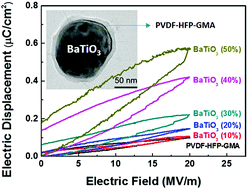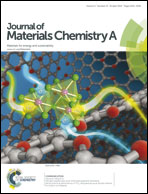“Grafting to” route to PVDF-HFP-GMA/BaTiO3 nanocomposites with high dielectric constant and high thermal conductivity for energy storage and thermal management applications†
Abstract
The introduction of high dielectric constant ceramic nanoparticles into an insulating polymer is an important approach to prepare high dielectric constant nanocomposites for electric energy storage applications. A key to obtaining desirable properties is the homogeneous dispersion of the nanoparticles in the corresponding polymer. Conventional methods used to improve the nanoparticle dispersion enhance the physical interaction between the nanoparticle and the polymer matrix via nanoparticle surface modification. In this work, the covalent bonding between the nanoparticle and the polymer matrix was utilized to simultaneously enhance the nanoparticle dispersion and nanoparticle/polymer interaction by functionalizing both the polymer and the nanoparticles. The poly(vinylidene fluoride-co-hexafluoropropylene) [PVDF-HFP] was functionalized with glycidyl methacrylate (GMA) via atom transfer radical polymerization. The barium titanate (BaTiO3) nanoparticles were modified by amino-terminated silane molecules. Then the nanocomposites were prepared by a “grafting to” method. Namely, grafting GMA functionalized PVDF-HFP to the surfaces of the BaTiO3 nanoparticles. The introduction of GMA into the PVDF-HFP not only increases the dielectric constant, but also changes the dielectric response of PVDF-HFP. More importantly, this “grafting to” approach results in core–shell structured BaTiO3@PVDF-HFP-GMA and thus a homogeneous dispersion of BaTiO3 nanoparticles in the nanocomposites. The dielectric constant, electric energy density and thermal conductivity of the nanocomposites are significantly enhanced with the increase of BaTiO3, while the dielectric loss shows a slight decrease as the nanoparticle loading increases.


 Please wait while we load your content...
Please wait while we load your content...